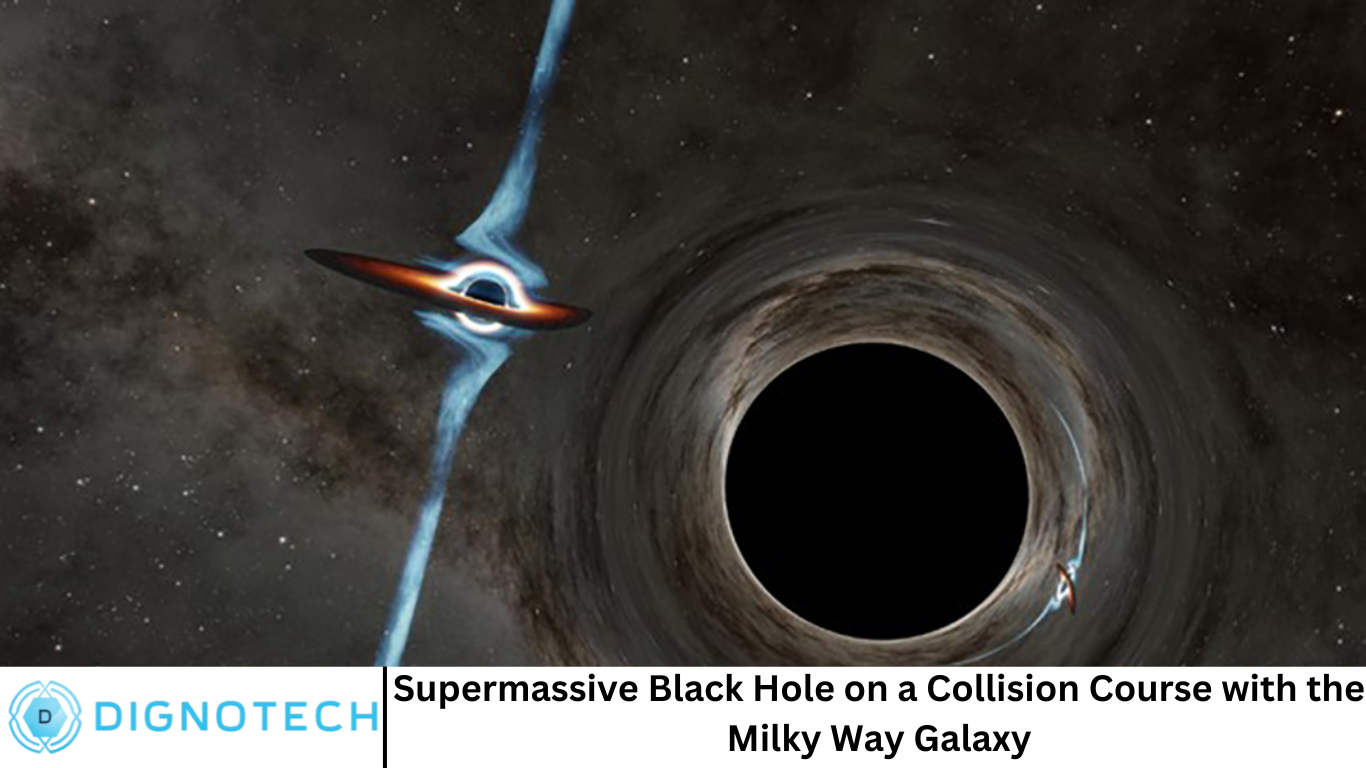Supermassive Black Hole on a Collision Course with the Milky Way Galaxy

Hi everyone! How are you all doing? Welcome to dignotech.com! The universe is filled with awe-inspiring cosmic phenomena that leave scientists and astronomers in a constant state of wonder. One of the most intriguing and mysterious objects in the cosmos is the supermassive black hole. These massive entities, with masses ranging from millions to billions of times that of our sun, are believed to reside at the centers of most galaxies, including our very own Milky Way. But what happens when a supermassive black hole is on a collision course with the Milky Way galaxy itself? What consequences will this cosmic event have for the galaxy and everything within it?
Understanding Supermassive Black Holes
Before diving into the implications of a supermassive black hole approaching the Milky Way, it’s important to first understand what supermassive black holes are and how they form. Supermassive black holes (SMBHs) are incredibly dense regions in space where gravity is so strong that not even light can escape. These objects are typically found at the centers of galaxies and can have masses ranging from millions to billions of times the mass of our sun. The event horizon is the point around a black hole beyond which nothing, not even light, can escape.
While the formation of SMBHs remains a topic of active research, one of the most widely accepted theories is that these black holes form when large clouds of gas collapse under their own gravity, or when stars with enormous masses collapse at the end of their life cycles. Over billions of years, they can grow even larger by consuming nearby gas, dust, and stars.
Supermassive Black Hole in the Milky Way: Sagittarius A*
The supermassive black hole at the center of our galaxy, the Milky Way, is known as Sagittarius A* (pronounced “Sagittarius A star”). It is roughly 4 million times the mass of our sun and is located about 26,000 light-years from Earth in the direction of the constellation Sagittarius. This black hole has been a subject of extensive study because, despite its immense size, it does not seem to be actively consuming large amounts of matter, which means it is relatively “quiet” compared to other active supermassive black holes found in some galaxies.
While it may appear calm today, it is crucial to note that Sagittarius A* exerts a tremendous gravitational influence on the stars and objects within the central region of the Milky Way. Its presence affects the orbital motions of nearby stars and could play a key role in shaping the galaxy’s structure.
What Does “Collision Course” Mean?
When we say a supermassive black hole is on a “collision course” with the Milky Way, we are not necessarily suggesting that the black hole is physically moving toward us in a straight line. Instead, this term refers to the idea that the Milky Way galaxy might one day merge with another galaxy, possibly resulting in an interaction with another supermassive black hole.
In fact, galaxies, including the Milky Way, are not static structures. They are constantly moving through space, and many galaxies are on collision courses with one another. One of the most famous upcoming galactic mergers is the collision between the Milky Way and the Andromeda galaxy, which is expected to occur in about 4.5 billion years. During this process, the supermassive black holes at the centers of both galaxies are likely to interact, eventually merging to form an even larger black hole.
The Future of the Milky Way: The Andromeda Collision
The upcoming collision between the Milky Way and Andromeda will have significant consequences for both galaxies. The process is likely to take billions of years, and during that time, stars will be scattered and thrown into different orbits, but due to the vast distances between individual stars, direct collisions between stars are unlikely. However, the true drama of this galactic collision will take place at the centers of both galaxies, where the supermassive black holes reside.
As the two galaxies begin to merge, their central black holes will eventually spiral toward each other due to the forces of gravity. Over time, these black holes will become closer and closer, eventually merging into a single, larger supermassive black hole. This merger will release an enormous amount of energy, likely in the form of gravitational waves—ripples in space-time that can be detected by sensitive instruments here on Earth.
The eventual result of this galactic collision and black hole merger will be a new, larger galaxy and a supermassive black hole at its center, possibly much larger than the current black hole at the center of the Milky Way.
Impact of the Collision on the Milky Way
While the merging of two supermassive black holes is a dramatic and energetic event, the actual impact on stars and planets within the Milky Way is less clear. Here’s what we do know:
- Star Orbits May Change: As the black holes draw closer, their intense gravitational pull could alter the orbits of nearby stars. Some stars could be ejected from the galaxy, while others could be drawn closer to the center, possibly even getting consumed by the black holes.
- Formation of New Stars: The merger could lead to the formation of new stars. The collision of gas clouds and the gravitational disturbances in the region could trigger the formation of new stars, although this process would take place over billions of years.
- Cosmic Radiation: The merging of supermassive black holes could create significant radiation, particularly in the form of X-rays and gamma rays. While these events would likely not directly harm life on Earth (due to the vast distance), they could create an extremely bright and energetic source in the sky, visible for billions of years.
- Gravitational Waves: One of the most important outcomes of the galactic merger will be the production of gravitational waves—ripples in the fabric of space-time that travel outward from the event. These waves will be detectable by specialized observatories, providing scientists with valuable information about black holes, galaxy mergers, and the nature of gravity itself.
- Event Horizon Growth: As the two black holes merge, the new, larger black hole will grow in size, possibly leading to an increase in the size of the event horizon, the boundary beyond which nothing can escape.
Will Earth Be Affected by the Collision?
Many people wonder whether Earth or the solar system will be affected by the collision between the Milky Way and Andromeda. Fortunately, the direct impact on Earth is likely to be minimal. Even though the gravitational forces from the supermassive black hole merger will be significant, the vast distances between stars mean that individual stars, including our sun, will likely not be directly affected by the gravitational pull.
However, the interaction between the two galaxies could cause some changes in the positions of stars within the Milky Way. The solar system might be displaced to a different part of the galaxy, but it is unlikely to be destroyed or directly impacted. Even so, the changes in the galaxy’s structure could alter the environment around Earth over long periods.
The Long-Term Future of Our Galaxy
Ultimately, the collision between the Milky Way and Andromeda, and the resulting merger of their supermassive black holes, represents a dramatic chapter in the long-term evolution of our galaxy. However, this event is still billions of years away, and by that time, the Earth itself will have undergone significant changes due to the natural evolution of the sun.
While the immediate future of our solar system is safe, the fate of the Milky Way and its supermassive black hole at the center will continue to be a subject of great interest to astronomers and astrophysicists. The ongoing research into black hole mergers, gravitational waves, and galaxy dynamics will help us gain a deeper understanding of these cosmic processes.
Frequently Asked Question
What is a supermassive black hole?
A supermassive black hole is a black hole with a mass ranging from millions to billions of times that of our sun. These black holes are typically found at the centers of galaxies, including the Milky Way.
What will happen when the Milky Way and Andromeda collide?
When the Milky Way and Andromeda collide, their supermassive black holes will eventually merge, creating a larger black hole. This event will release enormous energy in the form of gravitational waves and could lead to the formation of new stars.
Will the Earth be destroyed during the galaxy merger?
While the merger will have dramatic effects on the structure of the galaxy, Earth is unlikely to be destroyed. The distances between stars are so vast that direct collisions are unlikely, though the solar system could be displaced within the galaxy.
How long will the Milky Way and Andromeda take to merge?
The collision is expected to take place over the course of about 4.5 billion years. The merger itself will take even longer, with the supermassive black holes spiraling toward each other and eventually merging.
What are gravitational waves?
Gravitational waves are ripples in space-time caused by the acceleration of massive objects, like merging black holes. These waves travel at the speed of light and can be detected by specialized observatories on Earth.
How will the merging black holes affect the Milky Way?
The merging black holes will create a larger, more massive black hole at the center of the galaxy. The merger will likely cause gravitational disturbances, altering the orbits of stars and gas clouds within the galaxy.
Can we observe the merger of black holes?
Yes, scientists can observe the merger of black holes indirectly by detecting the gravitational waves emitted during the process. These waves provide valuable insights into the nature of black holes and the structure of the universe.
Conclusion
The idea of a supermassive black hole being on a collision course with the Milky Way is an exciting and dramatic concept. While such events are billions of years away, they provide a glimpse into the dynamic and ever-changing nature of the universe. The merging of galaxies and black holes will reshape the structure of our cosmic neighborhood, but life on Earth will likely continue, unaffected by these distant, yet fascinating, events. As technology improves and our understanding of black holes and gravitational waves advances, we will continue to learn more about the fate of the Milky Way and the mysteries of the universe.





